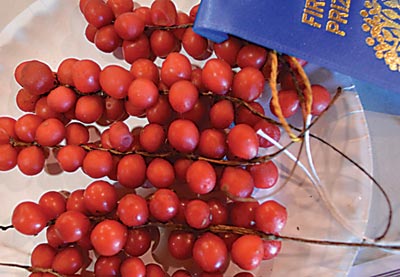 |
| Eastern Prince schisandra berries shown by Aaron Parker of Falmouth in the Common Ground Country Fair Exhibition Hall. English photo |
By Roberta Bailey
A few years ago, a friend was helping my husband and me erect a high tunnel on our farm. After a lunch break, he pulled out a little tincture bottle and said, “This is what keeps me going these days.” The bottle contained a deep red tincture of schisandra berries. I enjoy good health because I support my immune system diligently. Curiosity peaked, I started reading about the plant. What I learned motivated me to buy some organic dried berries and make my own tincture. In the year that followed, my house burned and my husband and I built a new house in less than six months. I took schisandra every day. I believe it supported me through the stress and the intense physical demand.
Schisandra chinensis is a woody vine in the Schisandraceae (Magnolia vine) family. Native to the forests of Northern China, the Russian Far East, Japan and Korea, it is hardy to zone 4. The 20- to 30-foot twisting, twining vines have alternate, deciduous, narrow leaves that average 2-1/2 inches in length. The plant is dioecious; male plants are required to pollinate female plants and set fruit. Berries are borne in grape-like clusters and ripen to a bright scarlet.
Edible and Medicinal
Schisandra berries are delicious. The Chinese name, wu wei zi, means five flavor berry and refers to its sweetness, bitterness, saltiness, pungency and sourness. The berries can be made into juices, wines, teas, sweets and tinctures. They can be eaten dried or fresh, even as a spritely surprise in a salad. Sun-dried berries are used in traditional Chinese medicine, often combined with other herbs.
This herb is an adaptogen, which means it has a broad spectrum of uses for health, and it reduces mental and physical stress. It is an overall tonic for increasing energy without increasing stress levels in your body. “Traditional Chinese physicians recommend schisandra in much the same way they recommend ginseng,” says Dr. James Duke – “as a general tonic and adaptogen that seems to normalize whatever is out of whack in the body.” (“The Green Pharmacy Herbal Handbook,” 2002)
The Memorial Sloan Kettering Cancer Center (https://www.mskcc.org/cancer-care/integrative-medicine/herbs/schisandra#field-herb-mechanism-of-action) says that in vitro lab test have shown anti-inflammatory and anticancer properties of schisandra. In animal studies, schisandra protected the liver against some toxins, was beneficial after myocardial infarction, enhanced endurance and metabolism, improved cognitive functioning, and showed antimicrobial, antioxidant, neuroprotective and anti-hyperglycemic activity. Isolated lignans reversed resistance of various cancer cell lines to some drugs.
The Cancer Center adds that few human trials have been performed with schisandra. A few small trials of schisandra combined with other compounds suggested improvements in subjects with fatty liver disease, possible benefit for those with chronic hepatitis C and improved cognitive performance. “Additional research is necessary to determine actual efficacy attributable to schisandra and to uncover possible interactions or side effects associated with this supplement,” says the Center, which cites research on three schisandra-drug interactions.
Growing Schisandra
The vines thrive in partial to full shade and in light, sandy to medium clay soils that are well-drained but moist, and amended with compost and a trace mineral mix such as azomite. The pH should be slightly acidic to slightly alkaline. The plants are easy to grow, seemingly disease- and insect-free in New England. They prefer a cool climate.
Plants are available from One Green World in Oregon and Fedco Trees in Clinton, Maine. They can also be started from seed, cuttings or by layering. Soak dry seeds overnight. Scarify or slightly knick the hard seed coat to aid in germination. Sow soaked seed indoors in March. Sow fresh seed in fall in a prepared garden bed, setting seed 1/4 inch
Plants need to be trellised on a high arbor like grapes or on a wall or fence. In Liaoning Province, China, the central area of harvest, vines are often cultivated in long rows on arbors. Plants should start to bear in three to four years.
Berries ripen in late summer or early fall. Pick when fully scarlet and process them fresh or dry them for later use.
In the words of Deb Soule of Avena Botanicals, “Schisandra holds the heart steady so one’s inner light can truly shine.” I certainly owe a lot to the plant.
This article is for informational purposes only. Please consult your health care practitioner before using medicinal herbs, especially if you are pregnant, breastfeeding or are taking medications with which herbs may interact.
